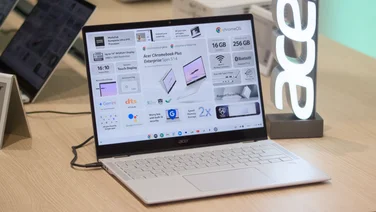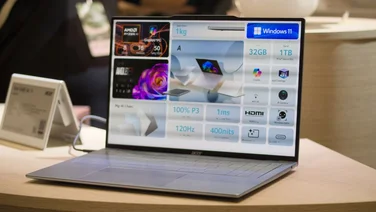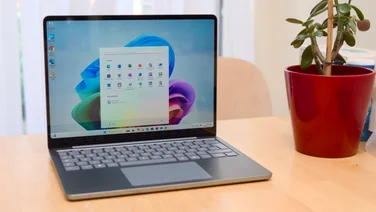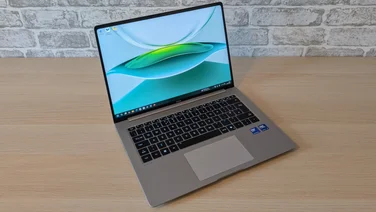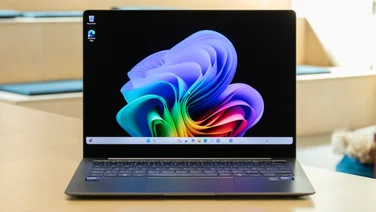To help us provide you with free impartial advice, we may earn a commission if you buy through links on our site. Learn more
















- Strong security features
- Speedy storage performance
- Overpriced
- Feels cheaply built
- Awful display quality
It’s possible this review will be the first time you’ve heard of Dynabook. In effect, Dynabook is a rebranding of Toshiba’s PC division, Toshiba Client Solutions (TCS), the majority share of which was sold to Sharp in late 2018. The brand’s name change from TCS to Dynabook took place on 1 January 2019, and going forwards Toshiba will not be releasing laptops under its own name.
Dynabook’s Portégé A30-E is one of the first new laptops to emerge under this new branding since Sharp acquired Toshiba’s PC assets. Sorry to say, it’s a bit of a flop, even if it’s not utterly without merit.
READ NEXT: The best business laptops
Dynabook Portégé A30-E review: What you need to know
The Portégé A30-E is a business-focused laptop that runs on Windows 10 Pro. The model I’ve been sent for review, the A30-E-143, has a 13.3in, 1,366 x 768 LCD display and is powered by an Intel Core i5-8250U that’s backed by 8GB of RAM. There’s an additional memory slot for expanding RAM up to a maximum of 24GB. It uses a 256GB PCIe SSD for storage and has a number of built-in security features, including a TPM 2 chip and Dynabook’s “unique BIOS”, which has been “engineered in-house for ultimate security”.
















Dynabook also says that the A30-E has passed various military-standard tests to be as robust as possible while remaining highly portable. That all sounds great on paper, but in reality, the laptop feels poorly designed with a plain black casing fashioned from what feels like fairly cheap plastic. To make things worse, the back and keyboard rests are lined with grooves that make it difficult to remove dirt, while the lid has excessive amounts of flex and wobble. It’s also impossible to open the laptop with a fluid one-handed movement because the hinge is too rigid.
















The chiclet-style keyboard is perfectly usable, even if it is just as cheap-feeling as the rest of the laptop. There’s a decent amount of travel and spacing between keys is fine, but just don’t press down on the flimsy keyboard plate with any force; there’s a lot of flex in it. As for the touchpad, it’s similarly tacky but still workable. If only the same could be said about the embedded fingerprint reader, which failed to recognise my fingerprint within minutes of setting it up.
















One thing the Portégé A30-E doesn’t fall short on is connectivity. The left-hand edge has a microSD reader, 3.5mm audio jack, HDMI output, USB Type-C 3.1 (DisplayPort) slot and the power jack. On the right, it’s got two USB Type-A 3.1 ports, an RJ-45 Ethernet jack and a security lock slot. For a compact laptop that’s a pretty generous offering.
















There are many reasons why I would not recommend you buy the Portégé A30-E and display quality is right at the top of that list. This 13.3in LCD panel has such a narrow range of viewing angles that you must stare at it practically dead-on, or else endure faded colours and markedly reduced visibility. It has a pitifully low maximum brightness of 259.8 cd/m2, a dreadfully dull 216:1 contrast ratio and, with an average Delta E of 10.35, some of the worst colour inaccuracy I’ve seen from any laptop display. Factor in the low-resolution, and you’re not really getting value for money here.

Performance isn’t great either, as the Portégé A30-E failed to match rival machines powered by the same Intel Core i5-8250U processor. As seen in the chart above, the Portégé A30-E managed an overall score of 54 in our in-house benchmark, compared to the 84 achieved by both the Dell Latitude 3300 Education and Microsoft Surface Laptop 2. The blame surely rests with a poor thermal management system. During testing, one of the four cores hit the maximum 100℃ safety limit, while the other three got up to between 96℃ and 97℃.

In our battery-rundown test, the Portégé A30-E lasted just under 11hrs, which is pretty decent considering the spec, but by no means exceptional. It does excel in one area at least, and that’s storage performance. In the AS SSD test, its 256GB PCIe SSD hit sequential read speeds of 2,093.4MB/sec and write speeds of 1,029.24MB/sec. These figures put it way out ahead of the business laptop competition.
Dynabook Portégé A30-E review: Price and competition
Dynabook claims that its Portégé A30-E delivers the high performance necessary to “support the workforce” and enable “new ways of working – at an affordable price point”. At £819 before VAT, I wouldn’t consider this model to be affordable in any way. And from the looks of things, it’s only available from the business-to-business retail channel, anyway.
















Looking for a machine that’s comparable in terms of size and performance? At £610, the 13.3in Dell Latitude 3300 Education is an excellent mid-range laptop at a fair price. Packing the same i5-8250U, and equipped with 8GB of RAM and a 256GB PCIe SSD, it’s better value than the Portégé A30-E and has superior CPU performance to boot.
And if you’re in a more luxuriant mood, you could pick up last year’s Microsoft Surface Laptop 2 with an i5-8250U, 8GB of RAM and 256GB SSD from Amazon for around £960.
Dynabook Portégé A30-E review: Verdict
The Dynabook Portégé A30-E is an overpriced business laptop with some serious flaws that render it frustrating, if not infuriating, to use. It’s well-equipped, sure, but thermal throttling holds back performance. As for the display quality, it’s well below what could be considered acceptable for a laptop that costs over £900.
















There was a time when Toshiba was a leader in business laptops, but Dynabook has a long way to go to match that legacy. This is one to avoid.
| Dynabook Portégé A30-E specifications | |
|---|---|
| Processor | Intel Core i5-8250U, qud-core,1.6-3.4GHz, Kaby Lake R,launched Q3 2017 |
| RAM | 8GB |
| Additional memory slots | 1 |
| Max. memory | 24GB |
| Graphics adapter | Intel UHD Graphics 620 |
| Graphics memory | 1GB |
| Storage | 256GB PCIe SSD |
| Screen size | 13.3in |
| Screen resolution | 1,366 x 768 |
| Pixel density | 117.8ppi |
| Screen type | LCD |
| Touchscreen | No |
| Pointing devices | Touchpad |
| Optical drive | No |
| Memory card slot | No |
| 3.5mm audio jack | Yes |
| Graphics outputs | HDMI, USB Type-C 3.1 (Gen 2) |
| Other ports | USB Type-A 3.1 x 2, microSD,RJ-45 Ethernet, security slot |
| Web Cam | HD, Windows Hello |
| Speakers | Stereo speakers |
| Wi-Fi | Wi-Fi 802.11ac+agn |
| Bluetooth | Bluetooth 4.2 |
| NFC | No |
| Dimensions (WDH) | 316 x 227 x 19.9mmm |
| Weight | 1.28kg |
| Operating system | Windows 10 Pro |
| Operating system restore option | Windows recovery drive |


